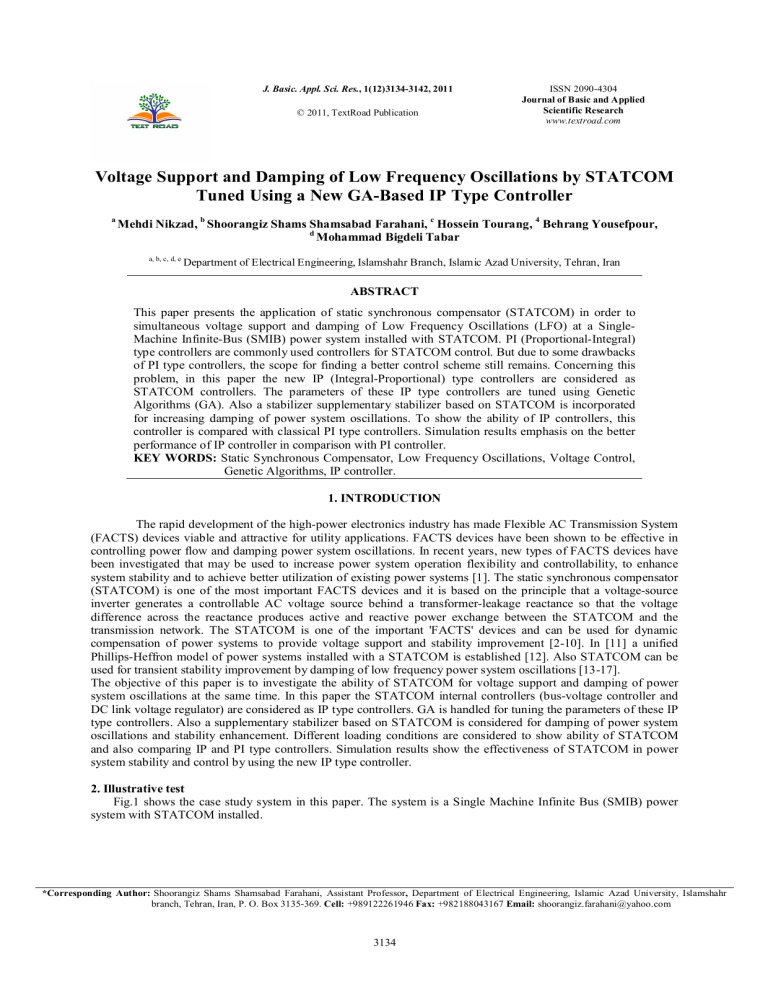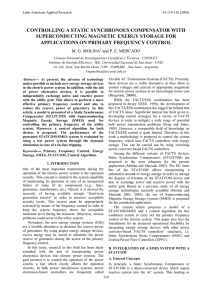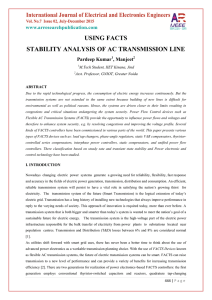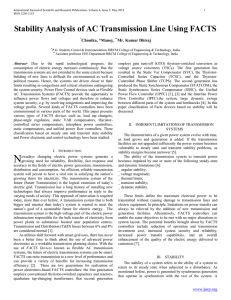Abstract - TEXTROAD Journals

J. Basic. Appl. Sci. Res., 1(12)3134-3142, 2011
© 2011, TextRoad Publication
ISSN 2090-4304
Journal of Basic and Applied
Scientific Research www.textroad.com
Voltage Support and Damping of Low Frequency Oscillations by STATCOM
Tuned Using a New GA-Based IP Type Controller
a
Mehdi Nikzad, b
Shoorangiz Shams Shamsabad Farahani, d c
Hossein Tourang,
Mohammad Bigdeli Tabar
4
Behrang Yousefpour, a, b, c, d, e
Department of Electrical Engineering, Islamshahr Branch, Islamic Azad University, Tehran, Iran
ABSTRACT
This paper presents the application of static synchronous compensator (STATCOM) in order to simultaneous voltage support and damping of Low Frequency Oscillations (LFO) at a Single-
Machine Infinite-Bus (SMIB) power system installed with STATCOM. PI (Proportional-Integral) type controllers are commonly used controllers for STATCOM control. But due to some drawbacks of PI type controllers, the scope for finding a better control scheme still remains. Concerning this problem, in this paper the new IP (Integral-Proportional) type controllers are considered as
STATCOM controllers. The parameters of these IP type controllers are tuned using Genetic
Algorithms (GA). Also a stabilizer supplementary stabilizer based on STATCOM is incorporated for increasing damping of power system oscillations. To show the ability of IP controllers, this controller is compared with classical PI type controllers. Simulation results emphasis on the better performance of IP controller in comparison with PI controller.
KEY WORDS: Static Synchronous Compensator, Low Frequency Oscillations, Voltage Control,
Genetic Algorithms, IP controller.
1. INTRODUCTION
The rapid development of the high-power electronics industry has made Flexible AC Transmission System
(FACTS) devices viable and attractive for utility applications. FACTS devices have been shown to be effective in controlling power flow and damping power system oscillations. In recent years, new types of FACTS devices have been investigated that may be used to increase power system operation flexibility and controllability, to enhance system stability and to achieve better utilization of existing power systems [1]. The static synchronous compensator
(STATCOM) is one of the most important FACTS devices and it is based on the principle that a voltage-source inverter generates a controllable AC voltage source behind a transformer-leakage reactance so that the voltage difference across the reactance produces active and reactive power exchange between the STATCOM and the transmission network. The STATCOM is one of the important 'FACTS' devices and can be used for dynamic compensation of power systems to provide voltage support and stability improvement [2-10]. In [11] a unified
Phillips-Heffron model of power systems installed with a STATCOM is established [12]. Also STATCOM can be used for transient stability improvement by damping of low frequency power system oscillations [13-17].
The objective of this paper is to investigate the ability of STATCOM for voltage support and damping of power system oscillations at the same time. In this paper the STATCOM internal controllers (bus-voltage controller and
DC link voltage regulator) are considered as IP type controllers. GA is handled for tuning the parameters of these IP type controllers. Also a supplementary stabilizer based on STATCOM is considered for damping of power system oscillations and stability enhancement. Different loading conditions are considered to show ability of STATCOM and also comparing IP and PI type controllers. Simulation results show the effectiveness of STATCOM in power system stability and control by using the new IP type controller.
2. Illustrative test
Fig.1 shows the case study system in this paper. The system is a Single Machine Infinite Bus (SMIB) power system with STATCOM installed.
*Corresponding Author: Shoorangiz Shams Shamsabad Farahani, Assistant Professor , Department of Electrical Engineering, Islamic Azad University, Islamshahr branch, Tehran, Iran, P. O. Box 3135-369.
Cell: +989122261946 Fax: +982188043167 Email: shoorangiz.farahani@yahoo.com
3134
Nikzad et al., 2011
Fig. 1. A single-machine infinite-bus power system installed with STATCOM
2.1. Nonlinear model of the system
A non-linear dynamic model of the system is derived by disregarding the resistances of all components of the system (generator, transformer, transmission line and shunt converter transformer) and the transients of the transmission lines and transformer of the STATCOM. The nonlinear dynamic model is given as (1) [11].
δ
E
E
q fd
V dc
P m
E
E
3m
4C
q fd
E dc
P
e
1
E
D fd
K
a
E
T
V
do
M ref
I
Ed
V t
T a
E
I
Eq
(1)
2.2. Linear model
A linear dynamic model is obtained by linearising the non-linear model around the nominal operating condition. The linearised model is given as (2).
w
0
w
P e
D
/ q
( E q
fd
1 T
A
E fd
/M
/ do
K
A
T
A
V t
v dc
K
7
K
8
E / q
K
9
v dc
K ce
m
E
K cδe
δ
E
Where
P e
K δ
1
K
2
E / q
K pd
v dc
K pe
m
E
K pδE
δ
E
(2)
E q
K
4
K
3
E
/ q
K qd
v dc
K qe
m
E
K qδE
δ
E
V t
K
5
K
6
E
/ q
K vd
v dc
K ve
m
E
K vδE
δ
E
Fig. 2 shows the transfer function model of the system including STATCOM. The model has constant parameters which are denoted by K ij
. These constant parameters are function of the system parameters and the initial operating condition. The control vector U in Fig. 2 is defined as (3).
U where,
E
E
]
T
(3)
3135
J. Basic. Appl. Sci. Res.
, 1(12)3134-3142, 2011
m
E
: Deviation in pulse width modulation index m
E
of shunt inverter. By controlling m
E
, the output voltage of the shunt converter is controlled.
E
: Deviation in phase angle of the shunt inverter voltage. By controlling
E
, exchanging active power between the
STATCOM and the power system is controlled.
It should be noted that K pu
, K qu
, K vu
and K cu
in Fig. 2 are the row vectors and defined as follows:
K pu
[ K pe
K pδe
];K qu
[ K qe
K qδe
];
K vu
[ K ve
K vδe
];K cu
[ K ce
K cδe
]
The dynamic model of the system in state-space form is obtained as (4). The typical values of system parameters for the nominal operating condition are given in appendix.
δ
w
E q
/
E fd
v dc
0
K
T
K
K
M
7
4
K K
T
/
1 do
A
5 w
0
0
0
0
0
0
K
2
M
K
T
/ do
3
K K
6
T
A
K
8
0
0
1
T
/ do
1
T
A
0
K
M
K
T pd qd
/ do
K K vd
T
A
0
K
9
w
E
E
/ q fd
v dc
0
K
M
K
T pe qe
K K
T
/ do
A
Kce ve
0
K
M
K
T
/ do
K
T
A
m
E
E
(4)
K
1
P e
P m
1
MS D w
0
S
K
4
K
5
K pd K pu
K
2
K
6
E
/ q
K
3
1
ST
/ do
K qu
K qd ka
1 ST a
V ref
K vu
K vd
K
8
U
K cu
1
S K
9
V dc
K
7
Fig. 2. Transfer function model of the system including STATCOM
3. IP controller
As referred before, in this paper IP type controllers are considered as STATCOM internal controllers. Fig.
3 shows the structure of IP controller. It has some clear differences with PI controller. In the case of IP regulator, at the step input, the output of the regulator varies slowly and its magnitude is smaller than the magnitude of PI regulator at the same step input [18]. Also as shown in Fig. 4, If the outputs of the both regulators are limited as the same value by physical constraints, then compared to the bandwidth of PI regulator the bandwidth of IP regulator can be extended without the saturation of the regulator output [18].
U i
K
P
U i, ref
K
I s
Fig. 3. Structure of the IP controller
U o
3136
Nikzad et al., 2011
Fig. 4. Output of IP and PI regulators with the same damping coefficient (
1
) and the same band width at the same step input signal command [18]
4. STATCOM controllers
In this paper three control strategies are considered for STATCOM: i.
Bus voltage controller ii.
iii.
DC voltage regulator
Power system oscillation-damping controller
4.1. Internal STATCOM controllers
STATCOM has two internal controllers which are Bus voltage controller and DC voltage regulator. In order to control of DC voltage, a DC-voltage regulator is incorporated. DC-voltage is regulated by modulating the phase angle of the shunt converter voltage. Fig. 5 shows the structure of the DC-voltage regulator. Also Fig. 6 shows the structure of the generator terminals voltage controller. The generator terminals voltage controller regulates the voltage of generator terminals during post fault in the system.
4.2. Power system oscillations-damping controller
A stabilizer controller is provided to improve damping of power system oscillations and stability enhancement. This controller is considered as a lead-lag compensator. This stabilizer provides an electrical torque in phase with the speed deviation in order to improve damping of power system oscillations. The transfer function model of the stabilizer controller is shown in Fig. 7.
V
DC
K
DP
V
DC, ref
V t
K
DI s
Fig 5. DC-voltage regulator
K
VP
Δδ
E
V t, ref
K
VI s
Fig 6. Generator terminals voltage controller
Δm
E
Fig 7. Stabilizer controller
3137
J. Basic. Appl. Sci. Res.
, 1(12)3134-3142, 2011
5. Analysis
For the nominal operating condition the eigen-values of the system are obtained using state-space model of the system presented in (4) and these eigen-values are listed in Table 1. It is seen that the system is unstable and needs to power system stabilizer (damping controller) for stability.
Table 1 - Eigen-values of the closed-loop system
-17.1146 , +0.0213
3.711i , -0.5401
0.4991i
5.1. Design of damping controller for stability
The damping controllers are designed to produce an electrical torque in phase with the speed deviation according to phase compensation method. The two control parameters of the STATCOM (m
E
and δ
E
) can be modulated in order to produce the damping torque. In this study m
E
is modulated in order to damping controller design also the speed deviation ∆ω is considered as the input to the damping controllers. The structure of damping controller has been shown in Fig. 7. It consists of gain, signal washout and phase compensator block. The parameters of the damping controller are obtained using the phase compensation technique. The detailed step-bystep procedure for computing the parameters of the damping controllers using phase compensation technique is presented by Kundur [19]. Damping controller has been designed and obtained as (5). damping controller
481 .
3021
s 0 .
1 s
s
s
4 .
712
5 .
225
(5)
The eigen-values of the system with stabilizer controller are listed in Table 2 and it is clearly seen that the system is stable.
Table 2 - Eigen-values of the closed-loop system with stabilizer controller
-18.4188 , -12.3155 , -5.8812 , -0.9251 0.9653 , -0.8211 0.7903
6. Internal STATCOM controllers design
After system stabilizing, the next step is to design the internal STATCOM controllers (DC voltage regulator and generator terminals voltage controller). As mentioned before, IP type controllers are considered for
STATCOM and these controllers are tuned using GA. In the next section an introduction about GA is presented.
6.1. Genetic Algorithms
Genetic Algorithms (GA) are global search techniques, based on the operations observed in natural selection and genetics. They operate on a population of current approximations-the individuals-initially drawn at random, from which improvement is sought. Individuals are encoded as strings (Chromosomes) constructed over some particular alphabet, e.g., the binary alphabet {0.1}, so that chromosomes values are uniquely mapped onto the decision variable domain. Once the decision variable domain representation of the current population is calculated, individual performance is assumed according to the objective function which characterizes the problem to be solved. It is also possible to use the variable parameters directly to represent the chromosomes in the GA solution. At the reproduction stage, a fitness value is derived from the raw individual performance measure given by the objective function and used to bias the selection process. Highly fit individuals will have increasing opportunities to pass on genetically important material to successive generations. In this way, the genetic algorithms search from many points in the search space at once and yet continually narrow the focus of the search to the areas of the observed best performance. The selected individuals are then modified through the application of genetic operators. In order to obtain the next generation
Genetic operators manipulate the characters (genes) that constitute the chromosomes directly, following the assumption that certain genes code, on average, for fitter individuals than other genes. Genetic operators can be divided into three main categories: Reproduction, crossover and mutation [20].
6.2. Controllers adjustment using GA
In this section the parameters of the proposed IP type controllers are tuned using GA. All two IP controllers are simultaneously tuned using GA. In this study the performance index is considered as (6). In fact, the performance index is the Integral of the Time multiplied Absolute value of the Error ( ITAE ). t t t
ITAE Δω dt dt t ΔV t dt
(6)
0
t
0
t ΔV
DC
0
Where, is the frequency deviation,
VDC
is the deviation of DC voltage, V t
is the deviation of bus voltage and parameter "t" in ITAE is the simulation time. It is clear to understand that the controller with lower ITAE is better than the other controllers. To compute the optimum parameter values, a 0.1 step change in mechanical torque
( Tm) is assumed and the performance index is minimized using GA. In order to acquire better performance,
3138
Nikzad et al., 2011 number of chromosomes, population size, cross over rate, mutation rate and number of iteration are chosen as 4, 12,
0.5, 0.05 and 70 respectively. The optimum values resulting from minimizing the performance index are presented in Table 3. In order to show effectiveness of IP method, the classical PI type controllers are also considered for
STATCOM control and the parameters of these PI type controllers are tuned using GA. The results are listed in
Table 4.
Table 3 - Optimum values of IP type controllers
IP controller of DC voltage K
DP
K
DI
9.5512
24.832
IP controller of Bus voltage K
VP
1.6711
30.301
PI controller of DC voltage
PI controller of Bus voltage
K
VI
Table 4 - Optimum values of PI type controller
K
DP
K
DI
K
VP
2.066
1.101
0.3201
Nominal operating condition
K
VI
IP
0.0101
33.812
7. RESULTS AND DISCUSSIONS
In order to evaluate the effectiveness of STATCOM and also comparing IP and PI type controllers, two operating conditions are considered as nominal and heavy operating conditions. The parameters for these two operating conditions are presented in the appendix. It should be note that IP and PI controllers have been designed for the nominal operating condition. In order to demonstrate the robustness performance of the proposed methods,
The ITAE is calculated following 5% step change in the reference mechanical torque ( Tm) at all operating conditions (Nominal and Heavy) and results are shown at Table 5. Following step change, the IP controller has better performance than PI at all operating conditions.
Table 5 –The calculated ITAE index for the both controllers
PI
0.0396
Heavy operating condition 0.0121 0.0419
The other important factor in the comparison of controllers is control effort signal. In this paper following index is considered to compare of the IP and PI controllers.
Control Effort t
0
t Δu dt
(7)
Where, u shows the control effort signal. The proposed metric is calculated for the both PI and IP controllers.
The results are listed in Table 6. The results show that the IP controller injects a lower control signal. Thus, in the case of IP controller, it is less probable to saturation of control signal.
Table 6 – The calculated control effort signal for the both controllers
Nominal operating condition
IP
2.043
PI
2.077
Heavy operating condition 2.160 2.181
Also simulation results following 0.05 step change in reference mechanical torque ( Tm) in the heavy operating condition are shown in Figs. 8-10. Each figure contains to plots as solid for IP controller and dashed for PI controller. Fig.8 shows that the DC voltage of STATCOM goes back to zero after disturbances and the steady state error has been removed and Fig. 9 shows the voltage of generator’s bus which is driven back to zero after oscillations. The results show that STATCOM can simultaneously control bus voltage and DC voltage. Fig. 10 shows the deviation of synchronous speed and it is seen that the supplementary stabilizer greatly enhances the damping of the power system oscillations and thus the system becomes more stable and robust. In all cases, the IP method has better performance than PI in control of power system and also stability enhancement.
3139
J. Basic. Appl. Sci. Res.
, 1(12)3134-3142, 2011
4
3
2
1
0
-1
-2
-6
-8
-10
-12
-14
-16
0
-2
-4
2 x 10
-3
-18
0 5 10 15
Time (s)
Fig. 8. Dynamic response V
DC
following 5% step change in the reference mechanical torque
Solid (IP controller); Dashed (PI controller) x 10
-3
6
5
-3
0 5 10 15
Time (s)
Fig. 9. Dynamic response V t
following 5% step change in the reference mechanical torque
Solid (IP controller); Dashed (PI controller)
3140
Nikzad et al., 2011
4
2
0
-2
-4
10 x 10
-4
8
6
-6
0 5 10 15
Time (s)
Fig. 10. Dynamic response ω following 5% step change in the reference mechanical torque
Solid (IP controller); Dashed (PI controller)
8. Conclusions
In this paper STATCOM successfully incorporated in order to simultaneous control of bus voltage and DC voltage. Also a supplementary stabilizer based STATCOM incorporated for damping power system oscillations and stability enhancement. Internal STATCOM controllers modeled as IP type and their parameters tuned using GA.
The simulation results showed that the STATCOM with IP controllers has better performance in control and stability than STATCOM with PI controllers. The multi objective abilities of STATCOM in control and stability successfully were showed by time domain simulations.
Appendix
The nominal system parameters are listed in Table 7. Also the system operating conditions are defined as
Table 8 (Operating condition 1 is the nominal operating condition).
Table 7 - System parameters
Generator
Excitation system
Transformers
Transmission lines
DC link parameters
STATCOM parameters
M = 8 Mj/MVA
X q
= 0.6 p.u.
T´ do
= 5.044 s
X´d = 0.3 p.u.
K a
= 10
X te
= 0.1 p.u.
X
T1
= 1 p.u.
V
DC
= 2 p.u.
X d
= 1 p.u.
D = 0
T a
= 0.05 s
X
SDT
= 0.1 p.u.
X
T2
= 1.25 p.u.
C
DC
= 3 p.u.
δ
E
=22.24
°
Operating condition 1 m
E
= 1.0224
Table 8 - System operating conditions
P = 1 p.u. Q = 0.2 p.u. V t
=1.03 p.u.
Operating condition 2 P = 1.08 p.u. Q = 0.25 p.u. V t
=1.03 p.u.
Acknowledgement
The authors gratefully acknowledge the financial and other support of this research, provided by Islamic
Azad University, Islamshahr Branch, Tehran, Iran.
3141
J. Basic. Appl. Sci. Res.
, 1(12)3134-3142, 2011
REFERENCES
[1] Hingorani N.G., and L. Gyugyi, 2000. Understanding FACTS. IEEE Press. New York.
[2] Gyugyi L., N.G. Hingorani, P.R. Nannery and T. Tai, 1990. Advanced Static Var compensator using Gate turn-off Thyristors for Utility Applications. In the Proceedings of the 1990 CIGRE Conference, pp: 23-203.
[3] Gyugyi L., 1979. Reactive Power Generation and Control by Thyristor Circuits. IEEE Trans., IA-15 (5): 521-
532.
[4] Schauder C., A.H. Mehta, 1993. Vector Analysis and Control of Advanced Static VAR Compensator. In the
Proceedings of the IEE conference, pp: 299-306.
[5] Schauder C., M. Gernhardt, E. Stacey, T.W. Cease and A. Edrise, 1995. Development of a ±100 MVAR
Static Condenser for Voltage Control of Transmission Systems. IEEE Trans on Power Delivery, 10 (3): 1486-
1496.
[6] Ekanayake J.B., N. Jenkins and C.B. Cooper, 1995. Experimental Investigation of an Advanced Static Var
Compensator. IEE Proc. Generation, Trans. and Distribution, 142 (2): 202-210.
[7] Saad-Saoud Z., M.L. Lisboa, J.B.E. Kanayake, N. Jenkins and G. Strbac, 1998. Application of STATCOMs to wind Farms. IEE Proc. Generation, Trans. and Distribution, 145 (5): 511-516.
[8] Trainner D.R., S.B. Tennakoon and R.E. Morrison, 1994.Analysis of GTO-Based Static VAR Compensators.
IEE Proc. Generation, Trans. and Distribution, 141 (6):293-302.
[9] Ainsworth J.D., M. Davies, J.B. Fitz, K.E. Owen and D.R. Trainer, 1998. Static Var Compensator
(STATCOM) Based on single-Phase Chain Circuit Converters. IEE Proc. Generation, Trans. and Distribution,
145 (4): 381-386.
[10] Mori S., K. Matsuno, M. Takeda and M. Seto, 1993. Development of a Large Static Var Generator Using
Self-commutated Inverters for Improving Power System Stability. IEEE Trans. Power System.
[11] Wang H.F., 1999. Phillips-Heffron model of power systems installed with STATCOM and applications. IEE
Proc. Generation, Trans. and Distribution, 146 (5): 521-527.
[12] Heffron W.G. and R.A. Phillips, 1952. Effect of a modem amplidyne voltage regulator on under excited operation of large turbine generator. AIEE Trans, pp: 71-80.
[13] Tambey N. and M.L. Kothari, 2003. Damping of Power System Oscillation with Unified Power Flow
Controller (UPFC). IEE Proc. Generation, Trans. and Distribution, 150 (2):129-140.
[14] Cheng S., O.P. Malik and S.G. Hope, 1986. Self-Tuning Stabilizers for a Multi-Machine Power System. IEE
Proceedings, Part C (4): 176-185.
[15] Al-Awami A.T., 2007. A Particle-Swarm-Based Approach of Power System Stability Enhancement with
UPFC. Electrical Power and Energy Systems, 29: 251-259.
[16] Mishra S., P.K. Dash and G. Panda, 2000. TS-Fuzzy Controller for UPFC in a Multi-Machine Power
System. IEE Proceedings on Generation, Transmission and Distribution, 147 (1): 15-22.
[17] Eldamaty A.A., S.O. Faried and S. Aboreshaid S, 2005. Damping Power System Oscillation Using a Fuzzy
Logic Based Unified Power Flow Controller. IEEE CCECE/CCGEI, 1, pp: 1950-1953
[18] Sul S.K., 2011. Control of Electric Machine Drive Systems, John Wiley & Sons, Inc., Hoboken, New Jersey.
[19] Kundur P., 1993. Power system stability and control. McGraw-Hill, Inc., New York, pp: 700-822.
[20] Randy L.H. and E.H. Sue, 2004. Practical Genetic Algorithms. John Wiley & Sons, Second Edition.
3142




